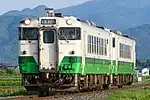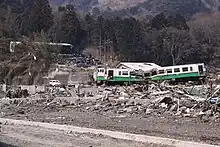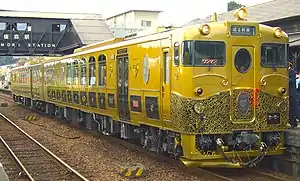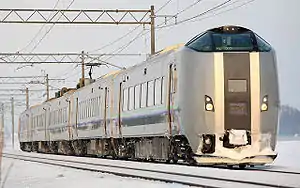KiHa 40 series
The KiHa 40 series (キハ40系, Kiha-yonjū-kei) is a diesel multiple unit (DMU) train type introduced by Japanese National Railways (JNR) in 1977 and operated by all Japan Railways Group companies on suburban and rural services in Japan.[2] Since 2017, the train type has seen use by other private railway companies in Japan, following the removal of services by Japan Railways groups. Additionally, it has also seen use in overseas operations in Myanmar since 2011.
| KiHa 40 series KiHa 41 KiHa 47 KiHa 48 | |
|---|---|
 A pair of JR East KiHa 40 series units on the Karasuyama Line in January 2017 | |
| In service | 1977–present |
| Manufacturer | Fuji Heavy Industries, Niigata Tekkō |
| Replaced | |
| Constructed | 1977–1983 |
| Number built | 888 vehicles |
| Number in service | 714 vehicles (as of 2018)[1] |
| Successor | |
| Formation | Various |
| Operator(s) |
|
| Depot(s) | Various |
| Line(s) served | Various |
| Specifications | |
| Car body construction | Steel |
| Car length | 21,300 mm (69 ft 11 in) |
| Width | 2,900 mm (9 ft 6 in) |
| Doors | 2 per side |
| Maximum speed | 95 km/h (59 mph) |
| Multiple working | KiHa 58 (San'in Main Line only) |
| Track gauge | 1,067 mm (3 ft 6 in) |
Overview
The KiHa 40 series diesel multiple unit was introduced in 1977 by JNR to replace ageing KiHa 10 series DMUs on suburban and rural services nationwide.[3] A total of 888 vehicles were built between 1977 and 1982, broadly divided into three main types: KiHa 40, KiHa 47, and KiHa 48. These were subdivided as shown below, with further variants and modifications made later in their lives by the various JR Group companies.[1]
| Type | No. of cabs | Doors | Subclass | Region | Toilet | Quantity | Numbering | Remarks |
|---|---|---|---|---|---|---|---|---|
| KiHa 40 | 2 | Single-leaf | -100 | Hokkaido (Extreme cold) | Yes | 150 | 101–250 | |
| -500 | Cold | 94 | 501–594 | |||||
| -1000 | Warm | No | 148 | 1001–1007 | Former KiHa 40-2000 cars with toilets removed | |||
| -2000 | Yes | 2001–2148 | ||||||
| KiHa 47 | 1 | Pairs | -0 | Warm | Yes | 193 | 1–193 | |
| -500 | Cold | 22 | 501–522 | |||||
| -1000 | Warm | No | 134 | 1001–1134 | ||||
| -1500 | Cold | 21 | 1501–1521 | |||||
| KiHa 48 | 1 | Single-leaf | -0 | Warm | Yes | 6 | 1–6 | |
| -300 | Hokkaido (Extreme cold) |
4 | 301–304 | |||||
| -500 | Cold | 59 | 501–559 | |||||
| -1000 | Warm | No | 4 | 1001–1004 | ||||
| -1300 | Hokkaido (Extreme cold) |
3 | 1301–1303 | |||||
| -1500 | Cold | 50 | 1501–1550 |
"Cold" regions refers to the Tohoku and Chubu regions.
JR Hokkaido
Following the privatization and splitting of JNR in April 1987, JR Hokkaido received a total of 157 KiHa 40 series vehicles (150 KiHa 40s and 7 KiHa 48s). As of 1 April 2010, JR Hokkaido operates 153 KiHa 40 series vehicles, classified as follows.[1]
- KiHa 40-300
- KiHa 40-330
- KiHa 40-350
- KiHa 40-400
- KiHa 40-700
- KiHa 40-1700
- KiHa 48-1300
- KiHa 400-100
- KiHa 480-300
- KiHa 480-1300
 KiHa 40 1740 in February 2022
KiHa 40 1740 in February 2022 KiHa 400-141
KiHa 400-141 Driver's cab of KiHa 40 1755 in September 2021
Driver's cab of KiHa 40 1755 in September 2021 Interior of KiHa 40 1716 in May 2021
Interior of KiHa 40 1716 in May 2021 Longitudinal seating of KiHa 40 1755 in September 2021
Longitudinal seating of KiHa 40 1755 in September 2021 Cross seating of KiHa 40 1755 in September 2021
Cross seating of KiHa 40 1755 in September 2021 Interior of KiHa 400-502
Interior of KiHa 400-502
JR East
Following the privatization and splitting of JNR in April 1987, JR East received a total of 219 KiHa 40 series vehicles (117 KiHa 40s, 28 KiHa 47s, and 74 KiHa 48s). As of 1 April 2010, JR East operates 159 KiHa 40 series vehicles, classified as follows.[1] KiHa 48 502 and KiHa 48 1512 were derailed and badly damaged by the 2011 Tōhoku earthquake and tsunami on 11 March 2011, and were withdrawn.
- KiHa 40-500
- KiHa 40-1000
- KiHa 40-2000
- KiHa 47-0
- KiHa 47-500
- KiHa 47-1000
- KiHa 47-1500
- KiHa 48-500
- KiHa 48-1500
 KiHa 40 584 in May 2018, Tohoku livery on Tadami Line
KiHa 40 584 in May 2018, Tohoku livery on Tadami Line KiHa 40 1003 in January 2011, repainted into old JNR livery
KiHa 40 1003 in January 2011, repainted into old JNR livery KiHa 47 515 in March 2017
KiHa 47 515 in March 2017 KiHa 48 519 in February 2021, Gono livery on Ōu Main Line
KiHa 48 519 in February 2021, Gono livery on Ōu Main Line KiHa 48 502 and KiHa 48 1512 after the tsunami in 2011
KiHa 48 502 and KiHa 48 1512 after the tsunami in 2011 Interior of KiHa 40-502 in May 2018
Interior of KiHa 40-502 in May 2018 Interior of KiHa 48 in April 2017
Interior of KiHa 48 in April 2017
Joyful Train sets
- Furusato (KiHa 48-2500)
- Kirakira Michinoku (KiHa 48)
- Resort Minori (KiHa 48-500)
- Resort Shirakami "Aoike" (KiHa 48)
- Resort Shirakami "Buna" (KiHa 48)
- Resort Shirakami "Kumagera" (KiHa 48)
- Umineko (KiHa 48)
- View Coaster Kazekko (KiHa 48)
- Koshino Shu*Kura (KiHa 40 and 48)
 KiHa 48 Furusato in November 2007
KiHa 48 Furusato in November 2007 Interior of View Coaster Kazekko
Interior of View Coaster Kazekko Koshino Shu*Kura on Shin'etsu Main Line
Koshino Shu*Kura on Shin'etsu Main Line Interior of Koshino Shu*Kura
Interior of Koshino Shu*Kura
JR Central
Following the privatization and splitting of JNR in April 1987, JR Central received a total of 59 KiHa 40 series vehicles (14 KiHa 40s, 5 KiHa 47s, and 40 KiHa 48s). By April 2010, JR Central operated 59 KiHa 40 series vehicles, classified as follows.[1] These were withdrawn by 2016.
- KiHa 40-3000
- KiHa 40-3300
- KiHa 40-5000
- KiHa 40-5500
- KiHa 40-5800
- KiHa 40-6000
- KiHa 40-6300
- KiHa 47-5000
- KiHa 47-6000
- KiHa 48-3500
- KiHa 48-3800
- KiHa 48-5000
- KiHa 48-5300
- KiHa 48-5500
- KiHa 48-5800
- KiHa 48-6000
- KiHa 48-6300
- KiHa 48-6500
- KiHa 48-6800
 KiHa 40 6300 in September 2004
KiHa 40 6300 in September 2004 KiHa 48 5500 in March 2008
KiHa 48 5500 in March 2008
JR West
Following the privatization and splitting of JNR in April 1987, JR-West received a total of 257 KiHa 40 series vehicles (63 KiHa 40s, 189 KiHa 47s, and 5 KiHa 48s). As of 1 April 2010, JR-West operates 255 KiHa 40 series vehicles, classified as follows.[1]
- KiHa 40-3000
- KiHa 41-2000
- KiHa 47-2000
- KiHa 47-2500
- KiHa 48-3000
- KiHa 48-3500
 KiHa 40 2007 in 1997
KiHa 40 2007 in 1997 KiHa 47 2503 in August 2007
KiHa 47 2503 in August 2007 Driver's cab of KiHa 47 1061 in December 2021
Driver's cab of KiHa 47 1061 in December 2021 Interior of KiHa 47 1061 in December 2021
Interior of KiHa 47 1061 in December 2021 Priority seating of KiHa 47 1061 in December 2021
Priority seating of KiHa 47 1061 in December 2021
Joyful Train sets
- Misuzu Shiosai (KiHa 47)
- Setonai Marine View (KiHa 47)
- Belles Montagnes et Mer (KiHa 40)
- Hanayome Noren (KiHa 48)
- Tenkū no shiro Takeda-jō ato (KiHa 40)
 Misuzu Shiosai in July 2011
Misuzu Shiosai in July 2011 Interior ofMisuzu Shiosai
Interior ofMisuzu Shiosai Setonai Marine View in March 2011
Setonai Marine View in March 2011 Interior ofSetonai Marine Viewin May 2016
Interior ofSetonai Marine Viewin May 2016 * Belles Montagnes et Mer
* Belles Montagnes et Mer Hanayome Noren in May 2016
Hanayome Noren in May 2016
JR Shikoku
Following the privatization and splitting of JNR in April 1987, JR Shikoku received a total of 53 KiHa 40 series vehicles (11 KiHa 40s and 42 KiHa 47s). As of 1 April 2010, JR Shikoku operates 43 KiHa 40 series vehicles, classified as follows.[1]
- KiHa 40-2000
- KiHa 47-0
- KiHa 47-500
- KiHa 47-1000
- KiHa 47-1500
 KiHa 47 118 in January 2020
KiHa 47 118 in January 2020 Interior of KiHa 47 in December 2018
Interior of KiHa 47 in December 2018
Joyful Train sets
- Iyonada Monogatari (KiHa 47)
 Iyonada Monogatari in May 2017
Iyonada Monogatari in May 2017 Interior of Iyonada Monogatari
Interior of Iyonada Monogatari
JR Kyushu
Following the privatization and splitting of JNR in April 1987, JR Kyushu received a total of 142 KiHa 40 series vehicles (36 KiHa 40s and 106 KiHa 47s). As of 1 April 2010, JR Kyushu operates 140 KiHa 40 series vehicles, classified as follows.[1]
- KiHa 40-7000
- KiHa 40-8000
- KiHa 47-3500
- KiHa 47-4500
- KiHa 47-5000
- KiHa 47-6000
- KiHa 47-8000
- KiHa 47-8500
- KiHa 47-9000
- KiHa 47-9500
- KiHa 140-2000
- KiHa 147-0
- KiHa 147-1000
 KiHa 40 8126 in January 2022
KiHa 40 8126 in January 2022 KiHa 47 9031 in August 2007, AQUA LINER livery on Kashii Line
KiHa 47 9031 in August 2007, AQUA LINER livery on Kashii Line Driver's cab of KiHa 40 8101 in January 2022
Driver's cab of KiHa 40 8101 in January 2022 Interior of KiHa 40 8126 in January 2022
Interior of KiHa 40 8126 in January 2022 Interior of KiHa 147 50 in December 2021
Interior of KiHa 147 50 in December 2021 Priority seating of KiHa 147 50 in December 2021
Priority seating of KiHa 147 50 in December 2021
Joyful Train sets
- Hayato no Kaze (KiHa 47/147)
- Ibusuki no Tamatebako (KiHa 47/140)
- Aru Ressha (KiRoShi 47)
- Two Stars 4047 (KiHa 47/147)
 Hayato no Kaze in January 2022
Hayato no Kaze in January 2022 Interior of Hayato no Kaze
Interior of Hayato no Kaze Ibusuki no Tamatebako in August 2012
Ibusuki no Tamatebako in August 2012 Interior of Ibusuki no Tamatebako
Interior of Ibusuki no Tamatebako Aru Ressha in October 2015
Aru Ressha in October 2015
Resale
Nishikigawa Railway
In 2017, 1 KiHa 40-1009 diesel carriage was taken over by Nishikigawa Railway, that ended operation on the Karasuyama Line by JR East in March 2017, the former diesel train is remodeled in retro style, and started operation on September 16 of the same year.[4]
 Former JR East KiHa 40 series DMU car KiHa 40-1009 at Nishikichō Station on the Nishikigawa Railway in Yamaguchi Prefecture, Japan.
Former JR East KiHa 40 series DMU car KiHa 40-1009 at Nishikichō Station on the Nishikigawa Railway in Yamaguchi Prefecture, Japan.
Kominato Railway
2 KiHa 40 carriages (KiHa 40-2021 and KiHa 40-2026), which ended operation on the Tadami Line in March 2020, were transferred to Kominato Railway in May 2020 with the Tohoku livery.[5][6]
 The former JR East KiHa 40 is scheduled to be transferred to Kominato Railway is detained at Soga Station.
The former JR East KiHa 40 is scheduled to be transferred to Kominato Railway is detained at Soga Station.
Hojo Railway
The latest acquisition purchased by the third-sector railway company which has been funded by the local government of Kasai City to purchase a retired unit from JR East which had been recently ended their local services in Gono Line on 2021.[7][8][9] The local government had been successfully collected their crowdfunding at a cost of about 30 million yen (approx. $220,000) for purchasing cost, shipment from the Akita prefecture and for remodeling or refurbishment to make it like new. The railcar has been successfully remodeled and started began their operation on March 2022 with retaining its former livery used in Gono Line by JR East. [10][11][8][9]
 Kiha 40-535 at Ao Station in May 2022
Kiha 40-535 at Ao Station in May 2022
Overseas operations

A large fleet of former KiHa 40 series cars from JR East, JR Hokkaido, JR Shikoku, and JR Central were shipped to Myanmar between 2011 and 2016. A total of 48 diesel cars (including KiHa 40, KiHa 47, & KiHa 48) have been shipped to Myanmar for overseas operations.[12] The cars are used on the Yangon Circular Railway.
Preserved examples
- KiHa 40 519: Next to Onagawa Station, Onagawa, Miyagi.[1] However, it was damaged by the 2011 Tōhoku earthquake and tsunami on 11 March 2011, and was withdrawn.
- KiHa 40 764: Next to Ikutora Station, Minamifurano, Hokkaido as a cutaway body. This DMU was modified to resemble a KiHa 12 unit and used in Yasuo Furuhata's 1999 film Poppoya (鉄道員, Poppoya / Tetsudōin, "Railwayman").[13]
 Preserved KiHa 40 519 next to Onagawa Station in September 2007
Preserved KiHa 40 519 next to Onagawa Station in September 2007 KiHa 40 764 in August 2011
KiHa 40 764 in August 2011
In popular culture
- The KiHa 140 is featured as a non-driveable train in the Microsoft Train Simulator computer game.[14]
- In 2017 NHK World-Japan dedicated an episode of their weekly show Japan Railway Journal to the KiHa 40 series.[15]
References
- Nishiwaki, Kōji; Fujita, Gorō (January 2011). キハ40系一族 [The KiHa 40 Series Family]. Japan Railfan Magazine. Vol. 51, no. 597. Japan: Koyusha Co., Ltd. pp. 15–63.
- Haraguchi, Takayuki (2009). Encyclopedia of JR's Railway Cars: JR全車輌. Japan: Sekai Bunka. pp. 126–127. ISBN 978-4-418-09905-4.
- Jēāru zensharyō handobukku: Rail Magazine 2009 JR全車輌ハンドブック2009 [JR Rolling Stock Handbook 2009]. Japan: Neko Publishing. 2009. pp. 461–470. ISBN 978-4-7770-0836-0.
- Toshihiko, Ninomiya. "山口)「キハ40形」錦川鉄道に到着 9月以降に運行". www.asahi.com (in Japanese). Archived from the original on 15 September 2020. Retrieved 24 May 2020.
- "鉄道ダイヤ情". www.kotsu.co.ja (in Japanese). Archived from the original on 23 May 2020. Retrieved 24 May 2020.
- "小湊鉄道 レア車両搬入で撮り鉄"密状態"に困惑「気持ちは分かるが、こんな時期なんで」". www.sponichi.co.jp (in Japanese). Archived from the original on 28 May 2020. Retrieved 24 May 2020.
- "北条鉄道 キハ40形購入". 読売新聞. 31 May 2021. Archived from the original on 31 May 2021. Retrieved 31 May 2021.
- "「キハ40」ようこそ北条鉄道へ 五能線の引退車両、来春から運行 人気の希少カラーリング". 神戸新聞. 神戸新聞社. 12 December 2021. Archived from the original on 15 December 2021. Retrieved 19 December 2021.
- "旧国鉄時代の「キハ40形」 希少な「白青」で走行へ 北条鉄道". 神戸新聞NEXT. 神戸新聞社. 27 August 2021. Retrieved 29 August 2021.
- "国鉄時代に製造のレア車両「キハ40形」再び出発進行! 北条鉄道". 神戸新聞NEXT. 神戸新聞社. 13 March 2022. Retrieved 16 March 2022.
- "北条鉄道で『キハ40満喫列車』運転". 鉄道ニュース. 交友社. 14 March 2022. Retrieved 16 March 2022.
- Diesel Railcars from Japan Archived 17 December 2020 at the Wayback Machine
- "キハ40 764" [KiHa 40 764]. rail.hobidas.com. Neko Publishing. 22 April 2014. Archived from the original on 11 July 2019. Retrieved 11 July 2019.
- "The Routes". Microsoft Train Simulator - Engineer's Handbook. Microsoft. 2001. p. 86.
- "Japan Railway Journal Episode 35 - The Unsung Hero of Japanese Railways: Series Kiha 40 Diesel Trains, Originally Aired Friday, June 16, 2017". Japan Railway Journal. NHK World-Japan. Archived from the original on 25 July 2021. Retrieved 26 September 2019.
Further reading
- Ishii, Yoshitaka (27 February 2009). キハ47物語: ローカル線の主役一般形キハの歩み キハ47物語 [The KiHa 47 story]. Japan: JTB Can Books. ISBN 978-4533074271.
External links
- JR Central KiHa 40/47/48 information (in Japanese)



